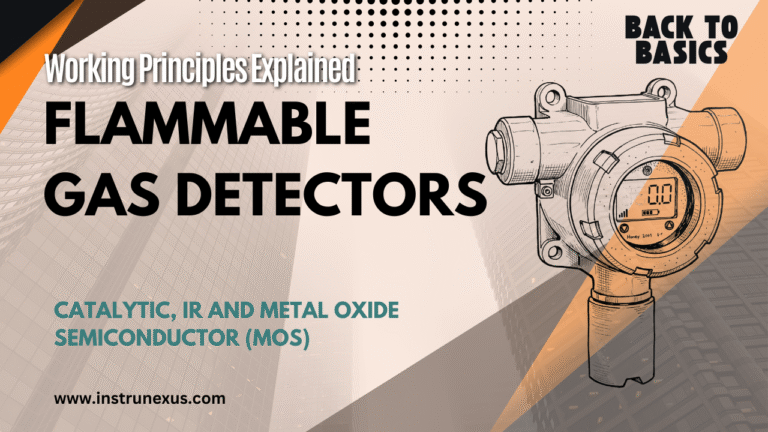
Interactive Guide to Flammable Gas Detectors
An overview of principles, technologies, and applications.
Why Gas Detection Matters
Flammable gas detectors are critical safety devices used to identify the presence of gases that can cause a fire or explosion. Industries like oil and gas, chemical manufacturing, mining, and wastewater treatment rely heavily on these detectors to protect personnel, property, and the environment. This guide provides an interactive exploration of the fundamental concepts, the different technologies available, and how to select the right detector for a specific application. Use the tabs above to navigate through the different sections and learn more.
Understanding the principles behind flammable gas detection, primarily the "flammability range," is the first step. From there, you can explore the various sensor technologies, each with its own strengths and weaknesses. This application will guide you through these topics, allowing you to compare technologies and understand their ideal use cases.
Core Concepts: The Flammability Range
For a fire or explosion to occur, a specific mixture of flammable gas and air (oxygen) must be present. This mixture is only flammable within a certain range. This concept is visualized below. Detectors are typically calibrated to measure the gas concentration as a percentage of the Lower Explosive Limit (% LEL).
Flammable Range Visualization
Lower Explosive Limit (LEL)
The minimum concentration of a gas in the air required for it to ignite. Below this level, the mixture is "too lean" to burn.
Flammable Range
The range of concentrations between the LEL and UEL where the gas-air mixture can ignite and explode.
Upper Explosive Limit (UEL)
The maximum concentration of a gas in the air for it to ignite. Above this level, the mixture is "too rich" (not enough oxygen) to burn.
Common Detection Technologies
Several technologies are used to detect flammable gases. Each operates on a different principle and has distinct advantages and limitations. Click on a technology below to learn more about its working principle, pros, and cons.
Catalytic Combustion (Pellistors)
This is one of the most common technologies for detecting combustible gases like methane and propane.
Principle
Uses two heated wire-coil elements (pellistors), one active and one reference. The active element is coated with a catalyst. When flammable gas is present, it oxidizes (burns) on the catalyst, raising the element's temperature and resistance. This change is measured relative to the reference element.
Pros
- Relatively low cost
- Good, linear response to many gases
- Robust and simple design
- Detects hydrogen, which IR cannot
Cons
- Requires oxygen to operate
- Sensors can be "poisoned" by silicones, lead, sulfur
- Sensor elements have a limited lifespan (2-5 years)
- Consumes more power than IR
Non-Dispersive Infrared (IR)
IR sensors are highly effective for detecting hydrocarbon gases (e.g., methane, butane, propane).
Principle
Works by passing infrared light through the gas sample. Hydrocarbon gas molecules absorb IR light at a specific, known wavelength. A detector measures how much light is absorbed, which is proportional to the gas concentration.
Pros
- Very long lifespan (10+ years)
- Does not require oxygen
- Immune to sensor poisoning
- Low maintenance, "fail-to-safety" design
- Can operate in high-concentration environments
Cons
- Higher initial cost
- Cannot detect hydrogen (H2)
- Less effective for some non-hydrocarbon gases
- Performance can be affected by high humidity/condensation
Metal Oxide Semiconductor (MOS)
MOS sensors are semiconductor devices used to detect a wide variety of gases, often at very low concentrations (ppm).
Principle
Uses a heated film of metal oxide. When a target gas interacts with the oxide surface, it changes the film's electrical resistance. This change in resistance is measured and correlated to the gas concentration.
Pros
- Very high sensitivity (can detect ppm levels)
- Fast response time
- Relatively low cost
- Detects a broad range of gases
Cons
- Can have high cross-sensitivity (responds to other gases)
- High power consumption due to heater
- Shorter lifespan compared to IR
- Sensitivity can be affected by humidity and temperature
Technology Comparison
Choosing the right technology involves trade-offs. The chart below provides a visual comparison of key performance metrics (on a relative scale of 1-10, where 10 is best/highest). The table provides a qualitative summary.
Sensor Performance Metrics (Relative)
Qualitative Comparison Summary
| Technology | Detects Hydrogen (H2)? | Requires Oxygen? | Poisoning Risk | Common Use |
|---|---|---|---|---|
| Catalytic | Yes | Yes | High (Silicones, Lead) | General combustibles (Methane, Propane) |
| Infrared (IR) | No | No | None | Hydrocarbons (Methane, Propane) |
| MOS | Yes | Yes | Low-Moderate | Broad-range/low-level (ppm) detection |
Applications & Selection
Gas detectors are broadly categorized into fixed and portable types. The right choice depends on the environment, the gases present, and the operational needs.
Detector Types
Fixed Gas Detectors
Permanently installed in a location to provide continuous monitoring. They are typically connected to a central control panel that can trigger alarms, activate ventilation systems, or shut down processes if a dangerous gas level is detected.
Portable Gas Detectors
Wearable or handheld devices used by personnel entering potentially hazardous areas (e.g., for confined space entry, leak detection, or personal safety monitoring). They provide immediate, localized alerts to the user.
Key Selection Criteria
Choosing the correct detector is a critical safety decision. Consider these factors:
- Target Gas: What specific gas(es) do you need to detect? (e.g., Methane, Hydrogen, Propane)
- Environment: Will the detector be in a very hot, cold, humid, or dirty area? Is oxygen always present?
- Technology: Does the environment contain substances that could poison a catalytic sensor? Is hydrogen present (ruling out IR)?
- Performance: What response time is needed? What concentration range (%LEL or ppm) is required?
- Certifications: Does the detector need to be certified for use in explosive atmospheres (e.g., ATEX, IECEx)?
- Cost & Maintenance: What is the total cost of ownership, including initial price, calibration, and sensor replacement?
